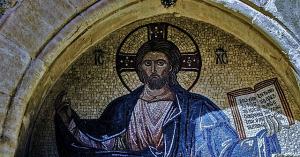 “Some Christians,” David Steinmetz observes, “have become concerned about the use of inclusive language in public worship. The traditional reference to God as Father, Son, and Holy Spirit, with its strongly patriarchal overtones, has troubled Christians who feel that more neutral language should be used in the church’s confessions and acts of public worship.”
“Some Christians,” David Steinmetz observes, “have become concerned about the use of inclusive language in public worship. The traditional reference to God as Father, Son, and Holy Spirit, with its strongly patriarchal overtones, has troubled Christians who feel that more neutral language should be used in the church’s confessions and acts of public worship.”
In the essay on inclusive language and the Trinity in his book of essays, Taking the Long View: Christian Theology in Historical Perspective, Steinmetz both examines if the Gloria is an adequate replacement and then examines the history of Trinitarian theology.
One of the less radical proposals is embodied in a new version of the “Gloria Patria,” which has been adopted by some congregations. The words run as follows:
Glory be to our Creator,
Praise to our Redeemer,
Lord Glory be to our Sustainer,
Ever three and ever one,
As it was in the beginning,
Ever shall be, amen.
The intention for such a re-examination of terms to use in public worship, Steinmetz says, is good and clear.
On the face of it, there seems to be nothing objectionable in this formulation. It is certainly appropriate in every generation for Christians to praise the activity of God as creator, redeemer, and sustainer. It is also appropriate for Christian congregations to try to find ways to use inclusive language in worship as long as the substance of the Christian faith can be preserved. Women have suffered from discrimination and repression in Western culture, not least at the hands of Christian churches. The use of more inclusive language is one way the church can repent of its sins and begin to lead a godly, righteous, and holy life.
Intentions here don’t match the theological need for Trinitarian theology.
The difficulty with this “Gloria” is that it is put forward as a trinitarian confession (“ever three and ever one”), when it is nothing of the kind. The doctrine of the Trinity is not merely the teaching that God is three in his historical self-revelation to us, while remaining one God, but that in the mystery of the unity of his inner life God is three to himself as well. It is an affirmation of the nature of unconditioned reality and not merely about the nature of revelation. Trinity is, like predestination, a doctrine that does not make complete sense in itself but does make luminous sense of other things.
The terms, in fact, are not Trinitarian terms at all. They refer to what God did and not Who God is.
“Creator,” “redeemer,” and “sustainer” refer to historical operations of God. To affirm that one God acted in these three roles is at best subtrinitarian and at worst a repetition of the old Sabellian heresy. Furthermore, if “creator” is looked upon as an exact replacement for “Father,” “redeemer” for “Son,” and “sustainer” for “Holy Spirit,” then both too much and too little is claimed for each person of the Trinity. If the Father is only creator and not redeemer and sustainer, if the Son is only redeemer and not creator and sustainer, if the Holy Spirit is only sustainer and not creator and redeemer, then the Bible becomes unintelligible. … You can see rather quickly why the church adopted the theological principle that the works of God ad extra, that is, directed outside himself, are indivisible. [That is, inseparable operations.]
He lets up just enough to say intentions are good but the result is worse.
Very probably the intention is to save the trinitarian formulation, while removing nothing more than the offending noninclusive language. Unfortunately, the results do not match the good intentions. It is clear, in other words, that if we are going to revise our language of worship, we have to pick up the debate where it left off and not proceed as though such a debate never took place.
Come back tomorrow for part two on this chapter.











